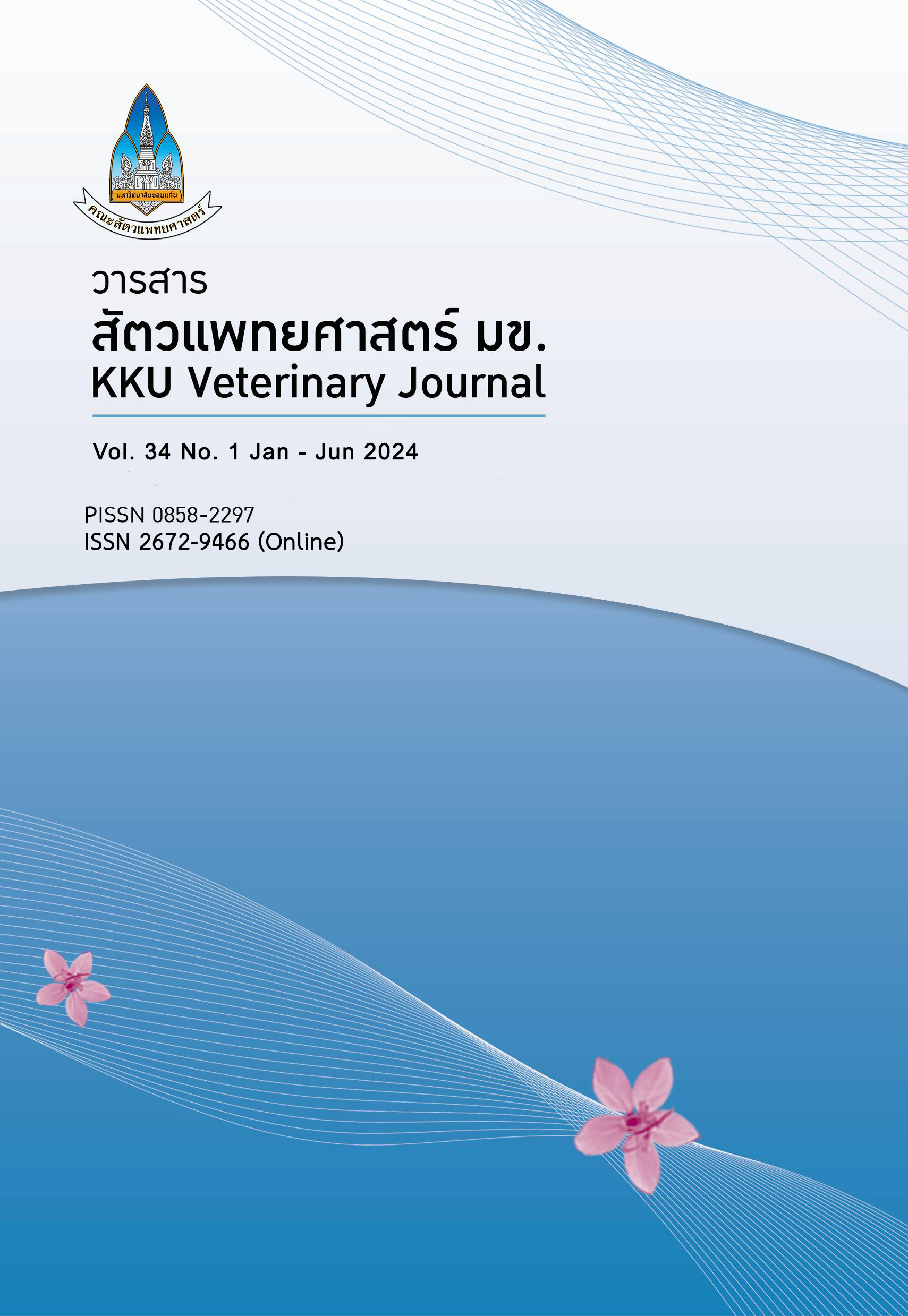Relationship Between Temperament and Nursing behavior in 72 Hours post-partum of Kamphaengsaen Beef Cattle
Main Article Content
Abstract
Objective: This study aims to examine the behavior and emotional states of beef cattle between cows exhibiting calm emotional states and cows exhibiting aggressive emotional states in relation to their nursing behaviors within 72 hours postpartum.
Materials and Methods: The reached sixteen Kamphaeng Saen cattle. The experiment's apparatus consists of a camera, a laptop, a chute test and an exit velocity test to assess the temperament status of the individual cows. Once the temperamental states are grouped, the temperamental states of the cows are grouped, and then their behavior is observed from the day before the prepartum period to 72 hours following postpartum. Information on nursing behavior was collected through the use of video recordings.
Results: The results of the temperament test using the chute test and the exit velocity test technique. The results showed that the low and high means chute scores were 1.67±0.31 and 4.00±0.33, with minimum and maximum exit velocities of 0.21±0.02 m/s and 0.54±0.19 m/s, respectively. Temperament groups were categorized on the basis of the average value of chute score and exit velocity: calm cattle (n = 7) and ill-tempered cattle (n = 9). The results show that the calmer cows have a delayed calving to-calf contact after postpartum compared to the ill-tempered cows, which take 6.57±0.24 seconds and 3.66±0.21 seconds, respectively. Ill-tempered cattle approach calves 72 hours after postpartum more often than calm cattle, namely 18.22±0.34 times and 13.28±0.39 times, respectively. However, calving to calf licking takes longer in calm cattle than in cattle with poor dispositions, namely 43.00±0.88 minutes and 37.55±0.77 minutes, respectively.
Conclusion: The temperamental state of cows has different influences on nursing behavior, such as contact between cows and calf, licking the calf and approaching the calf 72 hours after postpartum. This behavior showed the maternal behavior toward the calf nursing after postpartum. As a result, by understanding each individual cow's temperamental state, it is possible to manage them individually and reduce the possibility that farm stimuli alter their temperamental state and nursing behavior.
Article Details

This work is licensed under a Creative Commons Attribution-NonCommercial-NoDerivatives 4.0 International License.
References
Beckman DW, Enns RM, Speidel SE, Brigham BW, Garrick DJ, 2007. Maternal effects on docility in limousin cattle. J Anim Sci 85, 650-657.
Behrends SM, Miller RK, Rouquette FM, Randel RD, Warrington BG, Forbes TD, Welsh TH, Lippke H, Behrends JM, Carstens GE, Holloway JW, 2009. Relationship of temperament, growth, carcass characteristics and tenderness in beef steers. Meat Sci 81, 433-438.
Brown RS, Aoki M, Ladyman SR, Phillipps HR, Wyatt A, Boehm U, Grattan DR, 2017. Prolactin action in the medial preopticarea is necessary for postpartum maternal nursing behavior. Proc Natl Acad Sci USA 114, 10779–10784.
Bruno KA, Vanzant ES, Vanzant KA, McLeod KR, 2016. Relationships of a novel objective chute score and exit velocity with growth performance of receiving cattle. J Appl Anim Sci 94, 4819-4831.
Chenoweth PJ, Landaeta Hernandez AJ, Floercke C, 2014. Reproductive and maternal behavior of livestock. In Genetics and the Behavior of Domestic Animals Elsevier Amsterdam The Netherlands, 159–194.
Curley KO, Paschal JRJC, Welsh TH, Randel RD, 2006. Technical note: Exit velocity as a measure of cattle temperament is repeatable and associated with serum concentration of cortisol in brahman bulls. J Appl Anim Sci 84, 31-38.
Dwyer C, 2003. Behavioural development in the neonatal lamb: Effect of maternal and birth-related factors. Theriogenology 59, 1027–1050.
Francisco CL, Cooke RF, Marques RS, Mills RR, Bohnert DW, 2012. Effects of temperament and acclimation to handling on feedlot performance of bos taurus feeder cattle originated from a rangeland-based cow-calf system. J Appl Anim Sci 90, 5067-5077.
Geburt K, Friedrich M, Piechotta M, Gauly M, von Borstel UK, 2015. Validity of physiological biomarkers for maternal behavior in cows-A comparison of beef and dairy cattle. Physiol Behav 139, 361- 368.
Hoppe S, Brandt HR, Konig S, Erhardt G, Gauly M, 2010. Temperament traits of beef calves measured under field conditions and their relationships to performance. J Anim Sci 88, 1982-1989.
Hogan LA, McGowan MR, Johnston SD, Lisle AT, Schooley K, 2022. Suckling Behaviour of Beef Calves during the First Five Days Postpartum. Ruminants 2, 321–340.
Kour H, Patison KP, Corbet NJ, Swain DL, 2021 Recording cattle maternal behaviour using proximity loggers and tri-axial accelerometers. Appl Anim Behav Sci 240, 105-349.
Michenet A, Saintilan R, Venot E, Phocas F, 2016. Insights into the genetic variation of maternal behavior and suckling performance of continental beef cows. Genet Sel Evol 48, 1–12.
Meagher RK, Beaver A, Weary DM, von Keyserlingk MA, 2019. Invited A systematic of the effects of prolongedcow–calf contact on behavior, welfare, and productivity. J Dairy Sci 102, 5765–5783
Michael S, Reagan N, Jeremy P, Beth K, Andrew P, Janeen L, Paul B, 2023. Association of maternal temperament and offspring disposition on growth performance. Translational Animal Science 7, 1–9
Perez L, Orihuela A, Corro M, Rubio I, Cohen A, Galina CS, 2014. Maternal protective behavior of zebu type cattle (bos indicus) and its association with temperament. J Anim Sci 92, 4694-4700
Pornthep P, Jamroen T, Panwadee S, 2022. Measurement of temperament using chute test and exit velocity test in beef cattle. KKU Veterinary Journal 32, 93-98.
Rutherford W, Parish J, Smith T, Vann R, Strickland B, 2018. Effects of maternal behavior of crossbred beef cows at calving onadjusted 205-day calf weaning weights. J Anim Sci 96, 106.
Swain DL, Patison K, Heath B, Bishop-Hurley G, Finger A, 2015, Pregnant cattle associations and links to maternal reciprocity. Appl Anim Behav Sci 168, 10–17.
SAS, 2014. University-edition, sas institute inc, cary, north carolina.
Turner SP, Jack MC, Lawrence AB, 2014. Precalving temperament and maternal defensiveness are independent traits but precalving fear may impact calf growth. J Anim Sci 91, 4417-4425.
Von Keyserlingk MAG, and Weary DM, 2007. Maternal behavior in cattle. Horm Behav 52, 106-113.


